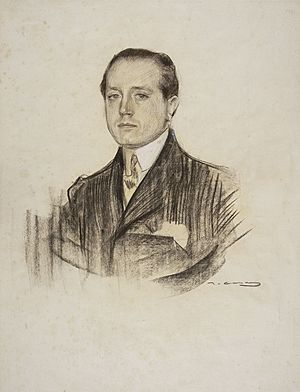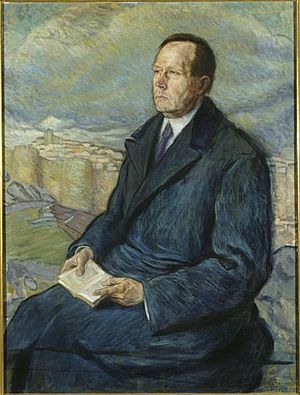José Martínez Ruiz facts for kids
Quick facts for kids
Azorín
|
|
|---|---|

Azorín in 1914
|
|
| Born |
José Augusto Trinidad Martínez Ruiz
8 June 1873 Monòver, Spain
|
| Died | 6 March 1967 (aged 93) Madrid, Spain
|
| Occupation |
|
| Years active | 1895–1967 |
| Seat P of the Real Academia Española | |
| In office 26 October 1924 – 6 March 1967 |
|
| Preceded by | Juan Navarro-Reverter |
| Succeeded by | Guillermo Díaz-Plaja |
José Augusto Trinidad Martínez Ruiz (born June 8, 1873 – died March 2, 1967) was a famous Spanish writer. He is much better known by his special pen name, Azorín. A pen name is a fake name a writer uses instead of their real one.
Azorín was a novelist (someone who writes books), an essayist (someone who writes short pieces about a topic), and a literary critic (someone who reviews books and other writings). When he was young, he had strong political ideas. He wrote in a simple and clear way. He was especially good at describing towns and landscapes in Spain.
Early Life and Education
José Martínez Ruiz was born in a village called Monòver, in Spain, on June 8, 1873. He was the oldest of nine children. He loved to read when he was young.
His father was a lawyer and a politician. His mother owned land nearby. From age eight to sixteen, José went to a boarding school in Yecla. This school was run by the Escolapius Fathers.
From 1888 to 1896, he studied law at the University of Valencia. However, he did not finish his studies. He started writing and published a book about literary criticism in 1893. He also wrote for local newspapers. He wrote for a newspaper called El pueblo, which had radical ideas.
He became interested in the ideas of Karl Christian Friedrich Krause. Krause believed that people could improve through education. He also thought that understanding other cultures could help overcome old ways of thinking.
In 1895, Ruiz wrote books about anarchist ideas. Anarchism is a political idea that believes in no government or rules. At this time, he was a political radical, meaning he wanted big changes in society.
Writing and Political Journey

José Ruiz moved to Madrid in 1896 and continued his journalism. He wrote for a republican newspaper called El País. He was fired because his ideas were too radical. He also wrote for other Spanish newspapers and an anarchist magazine in Paris. In his early writings, he often shared his anti-establishment views. He believed writing could help change things.
Around 1899, his ideas began to change. He started to think more about philosophy and art. He also became interested in the past. His books, like El alma castellana (The Castilian Soul), explored what it meant to be Spanish. He started to move away from revolutionary ideas. He became more of a nihilist, which means he believed that life had no real meaning. However, he still respected people.
In 1902, he published his first novel, La voluntad (Volition). He also wrote Antonio Azorín and Las confesiones de un pequeño filósofo. Early in his career, he used different pen names. In 1904, he decided to use "Azorín" as his main pen name. He used the name of one of his characters.
Azorín wrote using mostly short sentences. In his stories and essays, he focused on the small, lasting details of history and everyday life. He believed that time was a series of repeating events. In 1908, he married Julia Guinda Urzanqui. She stayed with him for the rest of his life. They did not have any children.
By 1913, he was writing for ABC, a popular newspaper that supported the monarchy. He wrote about "La generación de 1898" (Generation of 98). This was a group of Spanish writers and artists he belonged to.

Azorín served as a conservative politician in the Cortes Generales from 1907 to 1919. He even became an under-secretary for the Ministry of Public Instruction. He stopped being a politician because he did not agree with the dictatorship of General Primo de Rivera.
He became known as a drama critic and essayist. His literary criticism helped people discover new tastes in literature. It also made people excited about classic Spanish writings again. In 1924, he was chosen to join the Royal Spanish Academy. This is a very important group that studies the Spanish language.
He wrote plays, but his slow writing style made it hard to adapt to theater. One of his plays, El Clamor (The Cry), was a comedy about journalists making up stories. This led to him being kicked out of a journalists' association. He also started to be influenced by the avant-garde movement. This movement involved new and experimental art. He tried a personal version of surrealism in a short series of works called Lo invisible (The Invisible).
When the Republic began in Spain, he went back to his old progressive political ideas. He left ABC to write for republican newspapers. He also edited Revista de Occidente, a magazine that shared European philosophy.
When the Spanish Civil War started in 1936, Azorín went to Paris. He continued writing for an Argentine newspaper. He wrote a book about his time in exile called Españoles en París.
He returned to Spain in 1939. He found himself in "inner exile" because he had not openly supported the Franco government. At first, he was not allowed to get a press card. But he was helped by Ramón Serrano Suñer, a government minister. He had to accept Franco's government to be allowed back. He wrote for ABC again from 1941 to 1962. He published many new works that were like his earlier successful writings.
Later Life
In his old age, Azorín became a big fan of movies. He wrote many articles about them. He even said that "Cinema is the greatest form of art." He died in Madrid, Spain, on March 2, 1967, when he was 93 years old.
Azorín's journey from a radical journalist to a conservative writer is interesting. It shows how his ideas changed over time.
Honors
- 1917, He was named "Hijo Predilecto de Monòver," which means "Favorite Son of Monòver."
- 1924, He was elected to the Royal Spanish Academy.
- 1946, He received the Grand Cross of the Order of Isabella the Catholic.
- 1956, He received the Grand Cross of the Civil Order of Alfonso X, the Wise.
- 1969, His home in Monòver was turned into a museum, called Casa-Museo Azorín.
See also
 In Spanish: Azorín para niños
In Spanish: Azorín para niños
- List of essayists
- List of Spanish writers
- List of Spanish-language authors

